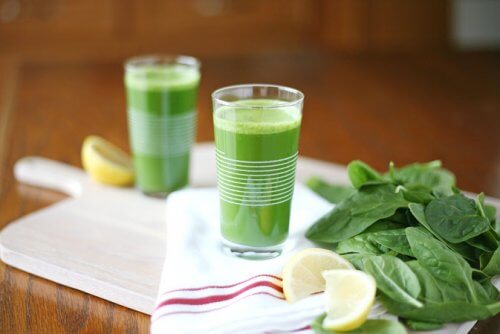A Great Morning Drink to Reduce Your Triglyceride Levels


Written and verified by psychologist Valeria Sabater
Cholesterol and triglycerides aren’t the same, despite popular belief. They’re both lipids, but only triglycerides are true fats, which depend on how many calories you consume.
Of course, you have to keep them both at an appropriate limit. For example, it’s best to not go beyond 150 mg of triglycerides per day.
If you’re wondering which is worse for you, the simple truth is that both cholesterol and triglycerides can cause serious complications if you overconsume them.
That’s why it’s vital to monitor how your daily cholesterol and triglycerides intake. It doesn’t matter how old you are: a good diet and an active lifestyle will help you keep both high cholesterol and high triglycerides at bay.
It’s also good to remember that triglyceride levels rise as your weight goes up or if you have too many calories.
That’s why today, we’re going to show you a special recipe: a drink to reduce your triglyceride levels. Having it as part of your breakfast can be a big help in the fight against these true fats. Plus, it’s easy, affordable, and very healthy.
The best foods to reduce your triglyceride levels
Triglycerides are the end product of digestion and the breakdown of fats found in food.
This is important to remember. While your body will use some of these fats as an energy source, it will dangerously store others in your abdomen.
- When we talk about cholesterol and triglycerides, we almost automatically think of adults. But these are two things we should be monitoring in children too.
- We already have a high rate of children with obesity and high triglyceride levels. Just keep in mind: the problem isn’t that children “eat a lot.” The real problem is that they “eat poorly.” Of course, so do many adults.
You might like:
Citrus Fruits Prevent Obesity and Strokes, According to Study
So, you shouldn’t focus on reducing the total amount of food we consume, you should focus on eating better. Be more conscientious and keep a balanced, varied diet.
Now, we’re going to talk about foods that can help you take better care of yourself if you have them in a smoothie in the morning.
Spinach: fabulous for reducing your triglyceride levels
- Spinach contains a large amount of lutein, a pigment in the carotenoid family that helps take care of your heart.
- Lutein acts as a “lubricant” for our arteries. This means it prevents them from hardening and removes the fat from cholesterol and triglycerides that stick to artery walls.
Apples: a miraculous fruit
There’s nothing better than starting the day with an apple. If you don’t have time to sit down and enjoy one bite by bite, make it part of this wonderful smoothie and you’ll still get all the benefits.
- Apples help reduce the level of triglyceride fats in the blood.
- The pectin and the polyphenols mostly found in apple peels helps fats metabolize better.
- So, it helps you reduce the production of a number of inflammatory molecules involved in various heart diseases.
Oats for your heart

They also make you feel fuller and more energized at the start of the day.
Read more:
Lemon: the miraculous fruit
We’ve talked about the health benefits of lemon lots on this blog. But, did you know that it lemon juice is also great for reducing your triglyceride levels?
- Thanks to the antioxidants and vitamins it contains, your body can increase fat combustion, which keeps it from storing them.
- It’s worth having the juice of at least half a lemon every day.
Now we’ll tell you how to make this amazing drink!
A natural drink to reduce your triglyceride levels

Ingredients
- 1 cup of fresh spinach (30 g)
- 1 apple
- 5 tablespoons of lemon juice (50 ml)
- 1 tablespoon of oats (10 g)
- 1 glass of water (200 ml)
Method
- The first thing you should do is wash the spinach and the apple. You’ll also need the apple peel. Cut it into four parts and remove the seeds from the center.
- All you have to do is put the apple pieces, spinach, lemon juice, spoonful of oats, and glass of water into the blender.
- Then, blend it all together until smooth and consistent.
Serve it in your favorite glass and always have it in the morning, during breakfast. If you have it at least three times a week and follow a proper diet, it should help you get some great results at your next triglyceride level analysis.
All cited sources were thoroughly reviewed by our team to ensure their quality, reliability, currency, and validity. The bibliography of this article was considered reliable and of academic or scientific accuracy.
- Queenan, K. M., Stewart, M. L., Smith, K. N., Thomas, W., Fulcher, R. G., & Slavin, J. L. (2007). Concentrated oat β-glucan, a fermentable fiber, lowers serum cholesterol in hypercholesterolemic adults in a randomized controlled trial. Nutrition Journal. https://doi.org/10.1186/1475-2891-6-6
- Nordestgaard, B. G., & Varbo, A. (2014). Triglycerides and cardiovascular disease. The Lancet. https://doi.org/10.1016/S0140-6736(14)61177-6
- Talayero, B. G., & Sacks, F. M. (2011). The role of triglycerides in atherosclerosis. Current Cardiology Reports. https://doi.org/10.1007/s11886-011-0220-3
- Li, T., Lu, X., Sun, Y., & Yang, X. (2016). Effects of spinach nitrate on insulin resistance, endothelial dysfunction markers and inflammation in mice with high-fat and high-fructose consumption. Food and Nutrition Research. https://doi.org/10.3402/fnr.v60.32010
- Scalbert, A., Johnson, I. T., & Saltmarsh, M. (2005). Polyphenols: antioxidants and beyond. The American Journal of Clinical Nutrition. https://doi.org/10.1093/ajcn/81.1.215S
- Butt, M. S., Tahir-Nadeem, M., Khan, M. K. I., Shabir, R., & Butt, M. S. (2008). Oat: Unique among the cereals. European Journal of Nutrition. https://doi.org/10.1007/s00394-008-0698-7
This text is provided for informational purposes only and does not replace consultation with a professional. If in doubt, consult your specialist.








